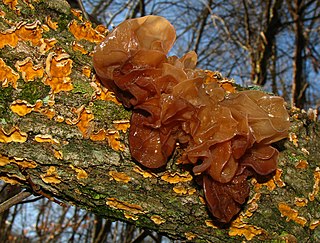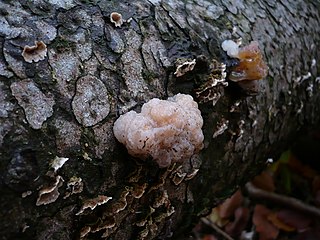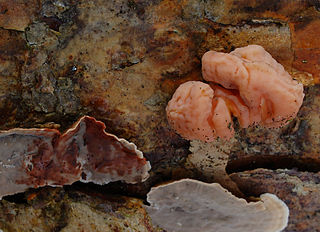
Phaeotremella frondosa is a species of fungus in the family Phaeotremellaceae producing brownish, frondose, gelatinous basidiocarps. It is widespread in north temperate regions, and is parasitic on other species of fungi that grow on dead attached and recently fallen branches of broadleaf trees.

Phaeotremella foliacea is a species of fungus in the family Phaeotremellaceae. It produces brownish, frondose, gelatinous basidiocarps and is parasitic on the mycelium of Stereum sanguinolentum, a fungus that grows on dead attached and recently fallen branches of conifers. It is widespread in north temperate regions. In the UK it has the recommended English name leafy brain and has also been called jelly leaf and brown witch's butter. Prior to 2017, the name Tremella foliacea was also applied to similar-looking species on broadleaf trees, now distinguished as Phaeotremella frondosa and Phaeotremella fimbriata.

Naematelia is a genus of fungi in the family Naemateliaceae. All Naematelia species are parasites of other fungi and produce anamorphic yeast states. When produced, basidiocarps, are gelatinous and are colloquially classed among the "jelly fungi." Four species of Naematelia are currently recognized worldwide. One species, Naematelia aurantialba, is commercially cultivated for food.

Naematelia aurantia is a species of fungus producing yellow, frondose, gelatinous basidiocarps. It is widespread in north temperate regions and is parasitic on another species of fungus that grows on dead attached and recently fallen branches of broadleaf trees. It is commonly called golden ear in North America.

Naematelia encephala is a species of fungus producing pink, brain-like, gelatinous basidiocarps. It is widespread in north temperate regions and is parasitic on another species of fungus that grows on dead attached and recently fallen branches of conifers. In the UK, its recommended English name is conifer brain.

Tremella iduensis is a species of fungus in the family Tremellaceae. It produces yellow, cornute-frondose, gelatinous basidiocarps and is parasitic on other fungi, probably species of Hypoxylon on dead attached and recently fallen branches of broad-leaved trees. It has been recorded from Japan and China. Tremella flava, described from Taiwan, may be a synonym.
Tremella dysenterica is a species of fungus in the family Tremellaceae. It produces bright yellow, red-spotted, lobed to subfrondose, gelatinous basidiocarps and is parasitic on other fungi on dead branches of broad-leaved trees. It was originally described from Brazil and has been recorded elsewhere in the neotropics and in Africa.
Tremella fibulifera is a species of fungus in the family Tremellaceae. It produces soft, whitish, lobed to frondose, gelatinous basidiocarps and is parasitic on other fungi on dead branches of broad-leaved trees. It was originally described from Brazil.
Tremella wrightii is a species of fungus in the family Tremellaceae. It produces light brown to orange-brown, lobed, gelatinous basidiocarps and is parasitic on other fungi on dead branches of broad-leaved trees. It was originally described from Cuba.

Tremella vesiculosa is a species of fungus in the family Tremellaceae. It produces light brown, lobed, gelatinous basidiocarps and is parasitic on other fungi on dead branches of broad-leaved trees. It was originally described from New Zealand.

Tremella samoensis is a species of fungus in the family Tremellaceae. It produces red to orange-yellow, lobed to firmly foliaceous, gelatinous basidiocarps and is parasitic on other fungi on dead branches of broad-leaved trees. It was originally described from Samoa and the Philippines, but is widely distributed in the region.
Tremella brasiliensis is a species of fungus in the family Tremellaceae. It produces yellow, lobed to firmly foliaceous, gelatinous basidiocarps and is parasitic on other fungi on dead branches of broad-leaved trees. It was originally described from Brazil.
Tremella rubromaculata is a species of fungus in the family Tremellaceae. It produces reddish orange, lobed, gelatinous basidiocarps and is parasitic on other fungi on dead branches of broad-leaved trees. It was originally described from Guatemala.
Tremella erythrina is a species of fungus in the family Tremellaceae. It produces orange to red, lobate to foliaceous, gelatinous basidiocarps and is parasitic on other fungi on wood of broad-leaved trees. It was originally described from China.
Tremella armeniaca is a species of fungus in the family Tremellaceae. It produces orange to apricot, lobed, gelatinous basidiocarps and is parasitic on other fungi on dead branches of broad-leaved trees. It was originally described from Costa Rica.
Tremella coffeicolor is a species of fungus in the family Tremellaceae. It produces brown, lobed to foliaceous, gelatinous basidiocarps and is parasitic on other fungi on dead branches of broad-leaved trees. It was originally described from Bermuda, where it was collected as part of the Challenger expedition.
Tremella exigua is a species of fungus in the family Tremellaceae. It produces small, dark, pustular, gelatinous basidiocarps and is parasitic on pyrenomycetous fungi on dead branches of trees and shrubs. It was originally described from France.
Tremella mesenterella is a species of fungus in the family Tremellaceae. It produces yellowish to reddish brown, foliose, gelatinous basidiocarps and is parasitic on corticioid fungi on dead branches of broadleaf trees and shrubs. It was originally described from Canada.
Tremella tremelloides is a species of fungus in the order Tremellales. It produces yellowish, brain-like to densely lobed, gelatinous basidiocarps and is parasitic on Stereum basidiocarps on dead branches of broadleaved trees. It was originally described from the USA.
Tremella steidleri is a species of fungus in the order Tremellales and has the recommended English name brown brain. It produces brown, brain-like, gelatinous basidiocarps and is parasitic on Stereum basidiocarps on dead branches of broadleaved trees. It was originally described from the Czech Republic.







